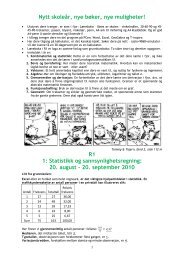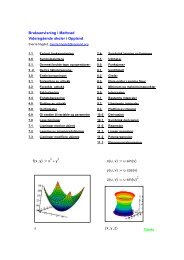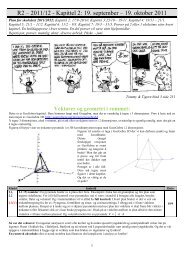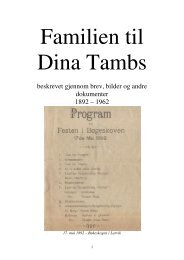Tall-leksikon - Matematikk på nett - Nordreisa videregående skole
Tall-leksikon - Matematikk på nett - Nordreisa videregående skole
Tall-leksikon - Matematikk på nett - Nordreisa videregående skole
Create successful ePaper yourself
Turn your PDF publications into a flip-book with our unique Google optimized e-Paper software.
Dagens tall:<br />
365,24219878<br />
• Ei tilnærming av antall dager eller døgn i ett år, dvs. hvor mange ganger Jorda<br />
snurrer rundt seg sjøl i løpet av den tida Jorda bruker <strong>på</strong> å gå en runde rundt Sola.<br />
Hadde matematikerne skapt verden, hadde sannsynligvis året vært <strong>på</strong> 360 dager –<br />
hvis skapelsen var utført før SI-systemet blei innført – eller 400 hvis SI skulle<br />
bestemt. Dette antallet utgjør 365 døgn 5 timer 48 minutter 45,9747 sekunder.<br />
Alle sivilisasjoner knytter året til månens faser, avstanden mellom 2 nye måner,<br />
som er <strong>på</strong> omtrent 29,530588 døgn, eller 29 døgn 12 timer 44 minutter og 2,8<br />
sekunder.<br />
Vi legger jo til ett døgn hvert fjerde år: Hvor mye feil blir dette? Og hva gjør vår den<br />
gregorianske kalenderen for at denne feilen ikke skal bli merkbar?<br />
Unfortunately, the relation cannot be a very simple one. It is coincidental that the length of the year in<br />
days is so close to the very round number, 360, which happens to be very close to 12 times the period<br />
of the moon. Such coincidences are helpful, but not enough, and immense ingenuity has been devoted<br />
to accounting for the differences. In the Julian calendar the ordinary years have 365 days but every<br />
year whose number is divisible by 4 has an extra day, the 29th February, making a total of 366 days.<br />
The average Julian year has therefore 365 . 25 days and is one day out approximately every 128 years.<br />
The Gregorian calendar, which is used today in most parts of the world, is a small but significant<br />
improvement on the Julian. All years divisible by 100 are ordinary years, not leap years, with the<br />
exception of years divisible by 400, which remain leap years. The Gregorian calendar contains one too<br />
many days every 3320 years, and so will not require adjustment until long after we are all dead. The<br />
Julian and Gregorian calendars are based on the length of the year and therefore on the sun. Given<br />
any day of the year, we can tell fairly accurately the position of the sun in the sky, but not the position<br />
of the moon. The Muslim calendar in contrast gives the moon precedence. It has 12 months of<br />
alternately 30 and 29 days. In a leap year the last month has an extra day. The ordinary year has only<br />
354 days and a leap year 355 days, so the start of the Muslim year moves steadily through the<br />
Gregorian year, and conversely. The Jewish year is a combination of solar and lunar years. The basic<br />
year is a lunar year of 12 months that are alternately of 30 and 29 days, but when the error amounts to<br />
a full month, a 13th month is inserted into that year. This makes it the most complicated by far of all<br />
calendars. The complications that are introduced when the solar year and the lunar month are<br />
considered together are well illustrated by the manner in which the date of Easter, which depends on<br />
the position of the moon, jumps around in the Christian year. The great Karl Friedrich Gauss<br />
demonstrated his insight into numbers by constructing simple formulae for calculating the date of the<br />
Christian Easter festival, and also, which is even more difficult, the date of the Jewish festival of the<br />
Passover.<br />
(Schocken, The Calculated Confusion of Calendars, Vantage Press, 1976)<br />
86








